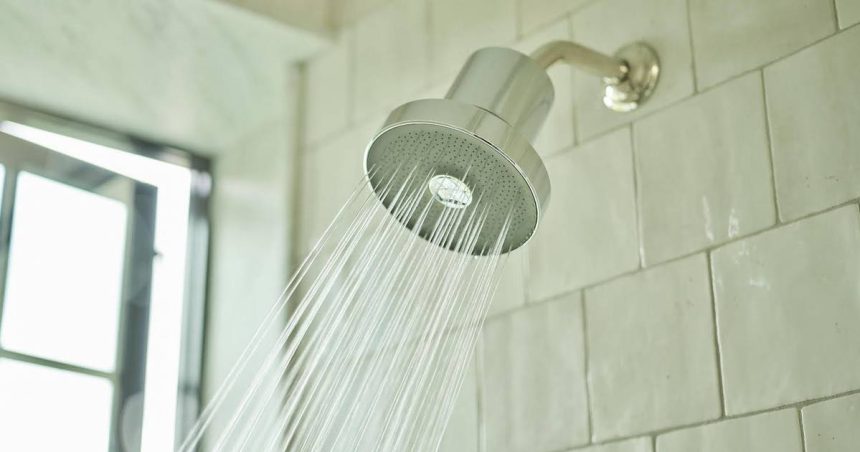A showerhead that costs $165 (or more, if you include the cost of quarterly shower-filter replacements) might seem like a luxury product to most. But that’s not how Arjan Singh, co-founder and head of brand marketing and operations at Jolie Skin Co.—which sells a showerhead that promises to filter out “chlorine, heavy metals, and other contaminants” to improve skin and hair health—sees it.
“We would not say Jolie as a product is a want or something that’s nice to have, but more a necessity,” he told Marketing Brew.
Since going to market in December 2021, Jolie’s showerhead has been featured in more than 25,000 pieces of user-generated content, according to Singh. The brand, which has more than 200k followers across Instagram and TikTok, has also run activations in the New York City area as part of what he says is an effort to generate conversation.
“Word of mouth—whether that’s word of mouth online or across the dinner table—that’s really the end goal,” Singh told us.
The company says it brought in $28 million in revenue last year, which Singh attributes in part to the brand’s marketing. By keeping operational costs low with a team of three and a robust gifting strategy that is “far lower” in cost than paid advertising, Singh said Jolie is able to reach audiences online and IRL to encourage them to add a Jolie showerhead to their existing beauty routines.
Jolie’s marketing strategy centers on product seeding to “not necessarily influencers, but people of influence,” Singh said, and the brand currently sends out free products on a monthly basis. (Singh declined to share the number of free products sent each year).
The brand has worked with well-known influencers like Devon Lee Carlson and Becca Moore, but Singh said the goal is not exclusively about racking up big-name endorsements; encouraging word-of-mouth recommendations can work just as well. “We want many different types of people to represent the brand,” he said.
While Singh said that Jolie isn’t “overly protective of who represents the brand,” it isn’t sending products without a strategy, either. Instead, Jolie’s marketing team targets people who it thinks are likely to be interested in the product at a time when inbound requests are exceeding outbound, he said. There’s a benefit to sending out a somewhat unconventional beauty product, too, according to Singh: most people aren’t getting many free showerheads in the mail, meaning they could be more likely to try the product, he said.
Jolie uses affiliate links, but it doesn’t provide discounts, and Singh said his team isn’t focused on the sometimes difficult task of trying to track individual creators’ contributions to sales anyway. Instead, they “look at it in the aggregate” to gauge the total impact of giveaways.
Get marketing news you’ll actually want to read
Marketing Brew informs marketing pros of the latest on brand strategy, social media, and ad tech via our weekday newsletter, virtual events, marketing conferences, and digital guides.
Jolie also doesn’t typically provide scripts or send briefs when it seeds products unless there’s a certain milestone approaching, like a holiday, Singh said. “We want the customer base to be the sales force, not necessarily the company,” he said. “That message should best be delivered by someone in their own words.”
In some cases, Singh says Jolie will put paid spend behind creator content, with most of it going toward TikTok (spend on Meta platforms, meanwhile, makes up somewhere in the single digits, percentage-wise, he said). In addition to creators, he said that Jolie has partnered with nearly 80 brands on everything from content to gift boxes to giveaways.
In the real world, Jolie is working to generate conversation with 15 Jolie-branded trucks driving around New York City with the message that people’s shower water could be dirtier than the truck’s exterior. “It has been, by far, the most successful form of marketing that we’ve done, measured by how many times it gets brought up to us or [posted],” Singh said.
The brand has also put stickers on the sidewalk outside upscale New York restaurants like Balthazar and The Odeon, as well as outside subway stations. It’s currently hosting a pop-up in SoHo with local store Happier Grocery and florist Audrey in the Garden.
This summer, Singh said the company will move to a house in the Hamptons for the third time, hosting events like yoga by the pool and a sushi and saké tasting on a sailboat.
This, too, could sound like luxury-brand positioning, but Singh said the activation is more about being culturally relevant and aligning with water. “Wherever there’s a cultural current, we’ll go there, because we know the impact that that has and the momentum that comes from that,” he said.
Product seeding combined with pop-ups and events has enabled Jolie to “spend online in a way that is a bit more sustainable from a cost perspective” and ensure it’s not overspending on marketing, Singh said.
As for potential customers’ spending? “We truly believe that Jolie is for everyone, no matter what your income level is,” he said, adding that the filters—which last for 90 days and retail for $33 each—cost less than 40 cents per day (excluding the initial cost of the showerhead, of course). And he feels sure that some consumers will shell out.
“We are vain creatures,” he said. “The willingness to spend on beauty and on our vanity, unfortunately for our society, is way beyond anything else that is in disproportion to one’s income.”
Read the full article here










